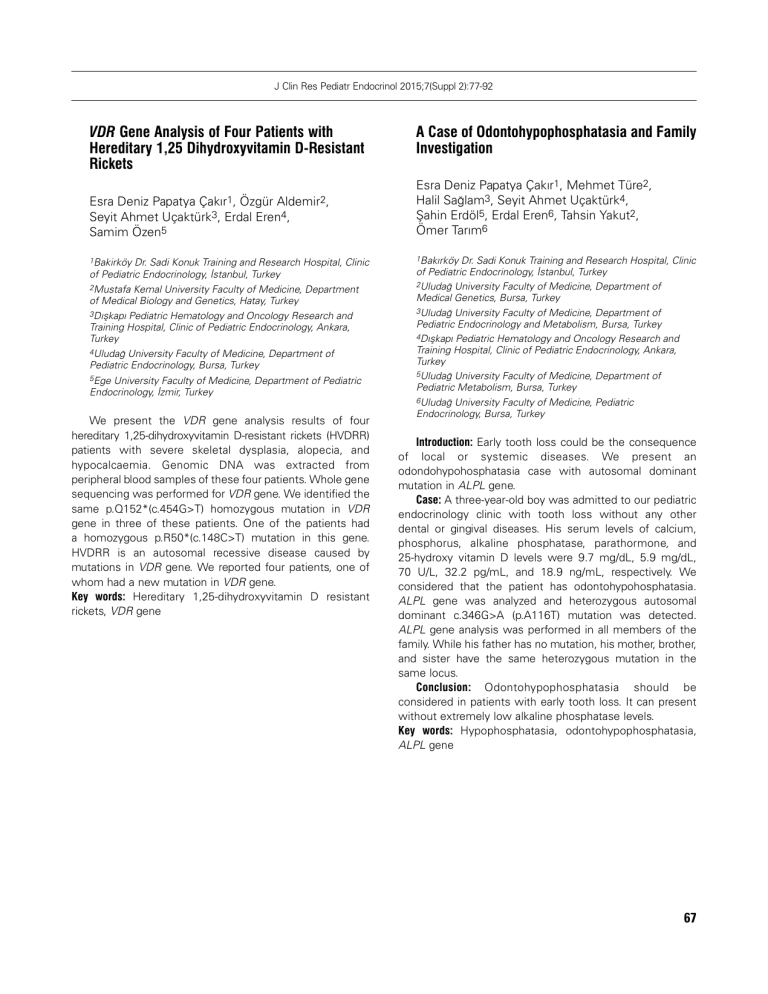VDR Gene Analysis of Four Patients with Hereditary 1,25
advertisement

J Clin Res Pediatr Endocrinol 2015;7(Suppl 2):77-92 VDR Gene Analysis of Four Patients with Hereditary 1,25 Dihydroxyvitamin D-Resistant Rickets A Case of Odontohypophosphatasia and Family Investigation Esra Deniz Papatya Özgür Seyit Ahmet Uçaktürk3, Erdal Eren4, Samim Özen5 Esra Deniz Papatya Çakır1, Mehmet Türe2, Halil Sağlam3, Seyit Ahmet Uçaktürk4, Şahin Erdöl5, Erdal Eren6, Tahsin Yakut2, Ömer Tarım6 1Bakirköy 1Bakırköy Çakır1, Aldemir2, Dr. Sadi Konuk Training and Research Hospital, Clinic of Pediatric Endocrinology, İstanbul, Turkey 2Mustafa Kemal University Faculty of Medicine, Department of Medical Biology and Genetics, Hatay, Turkey 3Dışkapı Pediatric Hematology and Oncology Research and Training Hospital, Clinic of Pediatric Endocrinology, Ankara, Turkey 4Uludağ University Faculty of Medicine, Department of Pediatric Endocrinology, Bursa, Turkey 5Ege University Faculty of Medicine, Department of Pediatric Endocrinology, İzmir, Turkey We present the VDR gene analysis results of four hereditary 1,25-dihydroxyvitamin D-resistant rickets (HVDRR) patients with severe skeletal dysplasia, alopecia, and hypocalcaemia. Genomic DNA was extracted from peripheral blood samples of these four patients. Whole gene sequencing was performed for VDR gene. We identified the same p.Q152*(c.454G>T) homozygous mutation in VDR gene in three of these patients. One of the patients had a homozygous p.R50*(c.148C>T) mutation in this gene. HVDRR is an autosomal recessive disease caused by mutations in VDR gene. We reported four patients, one of whom had a new mutation in VDR gene. Key words: Hereditary 1,25-dihydroxyvitamin D resistant rickets, VDR gene Dr. Sadi Konuk Training and Research Hospital, Clinic of Pediatric Endocrinology, İstanbul, Turkey 2Uludağ University Faculty of Medicine, Department of Medical Genetics, Bursa, Turkey 3Uludağ University Faculty of Medicine, Department of Pediatric Endocrinology and Metabolism, Bursa, Turkey 4Dışkapı Pediatric Hematology and Oncology Research and Training Hospital, Clinic of Pediatric Endocrinology, Ankara, Turkey 5Uludağ University Faculty of Medicine, Department of Pediatric Metabolism, Bursa, Turkey 6Uludağ University Faculty of Medicine, Pediatric Endocrinology, Bursa, Turkey Introduction: Early tooth loss could be the consequence of local or systemic diseases. We present an odondohypohosphatasia case with autosomal dominant mutation in ALPL gene. Case: A three-year-old boy was admitted to our pediatric endocrinology clinic with tooth loss without any other dental or gingival diseases. His serum levels of calcium, phosphorus, alkaline phosphatase, parathormone, and 25-hydroxy vitamin D levels were 9.7 mg/dL, 5.9 mg/dL, 70 U/L, 32.2 pg/mL, and 18.9 ng/mL, respectively. We considered that the patient has odontohypohosphatasia. ALPL gene was analyzed and heterozygous autosomal dominant c.346G>A (p.A116T) mutation was detected. ALPL gene analysis was performed in all members of the family. While his father has no mutation, his mother, brother, and sister have the same heterozygous mutation in the same locus. Conclusion: Odontohypophosphatasia should be considered in patients with early tooth loss. It can present without extremely low alkaline phosphatase levels. Key words: Hypophosphatasia, odontohypophosphatasia, ALPL gene 67